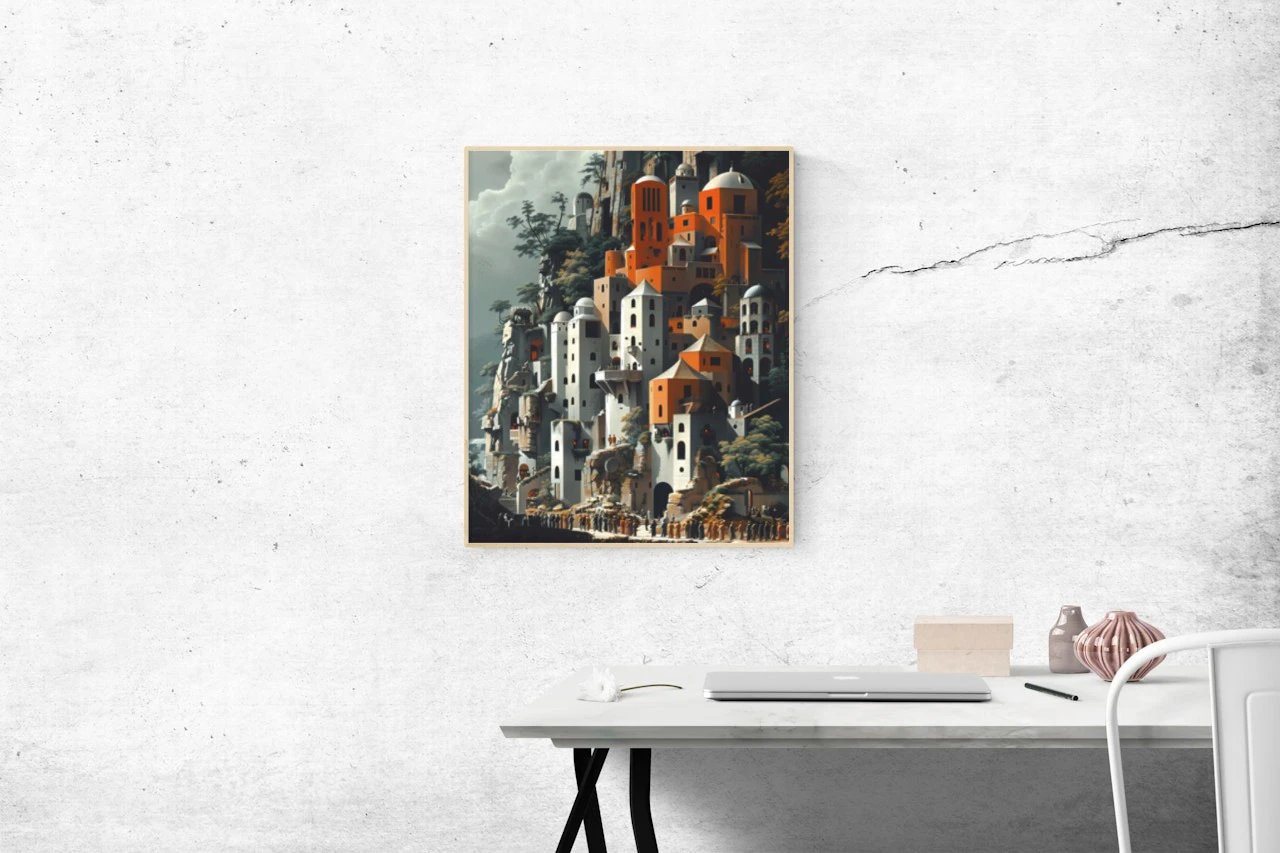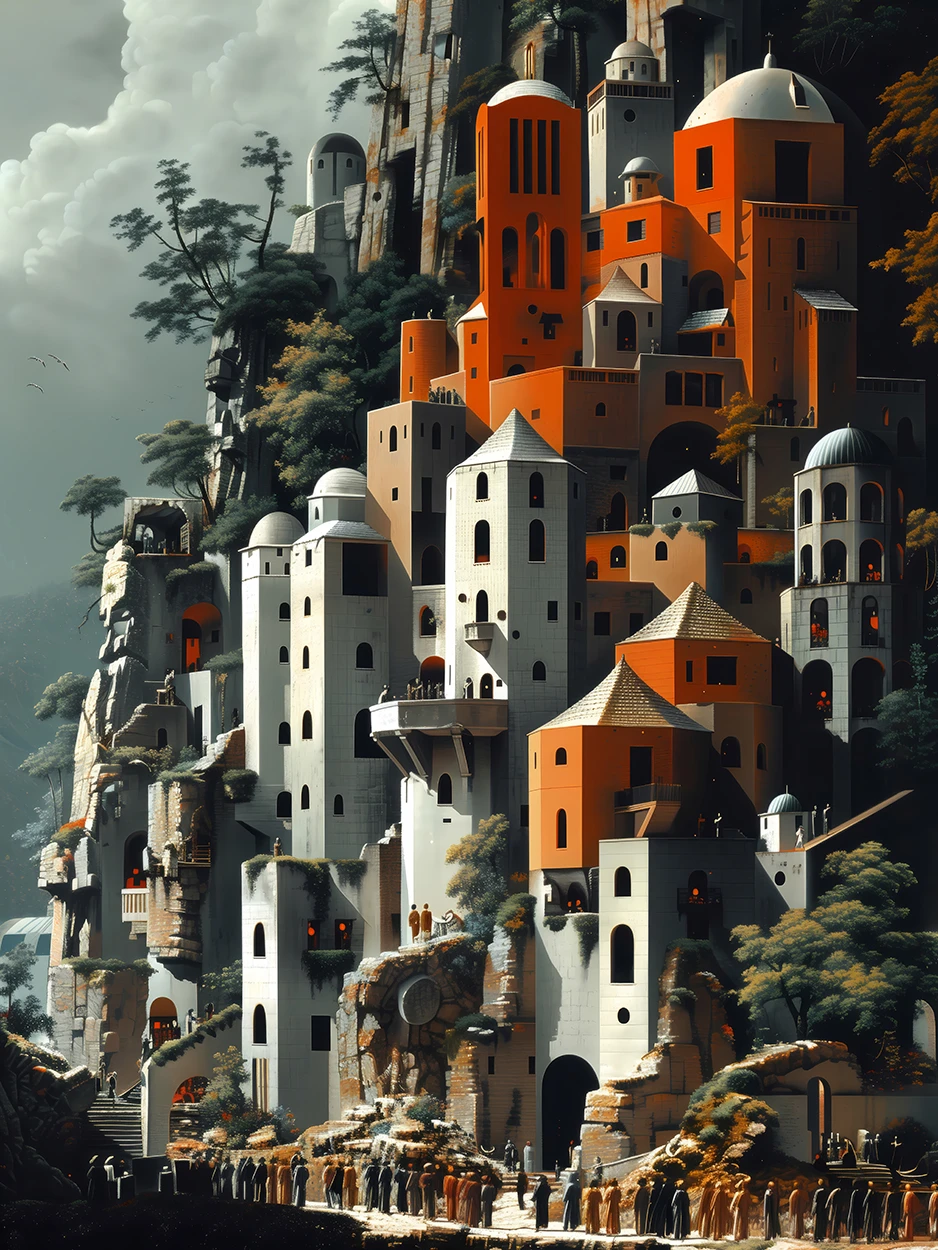Nobles in High Castles
In Nobles in High Castles, the artist presents a striking and towering architectural landscape, where the grandeur of the built environment dominates the scene. The imposing structure, carved into cliffs, rises dramatically against a cloudy sky. This piece evokes a sense of wonder and hierarchy, with its mix of fortresses, watchtowers, and domed halls. The varied shapes of the buildings, from square towers to rounded domes, suggest a civilization that values complexity and grandeur.
The dominant orange hues of some structures contrast sharply with the neutral whites and grays, creating a vibrant yet somber mood. The orange, almost regal in its intensity, may symbolize the nobility, wealth, or power housed within these high castles. The use of geometric precision in the buildings lends the work a dreamlike quality, as if the city itself is an imagined utopia built upon centuries of tradition and power.
At the base of the structure, a line of figures, draped in robes, moves solemnly, adding a sense of ritual or procession. Their small size in comparison to the immense architecture emphasizes the power imbalance between the nobles who inhabit the castles above and the common people below. The figures’ placement and movement through the narrow passageways add a human scale to the otherwise vast and overpowering environment, reminding the viewer of the roles people play within such structured societies.
The vegetation, scattered across the cliffside, softens the rigid lines of the architecture, suggesting that despite the dominance of human creation, nature still clings to the edges of this world. The trees and foliage growing on the rock face offer a reminder that even in the most artificial, controlled environments, nature is never completely eradicated.
Through this carefully orchestrated scene, the artist seems to be making a statement about the separation of classes, with the nobles living above, disconnected from the world below. The architecture of the city, grand yet almost inaccessible, reflects the isolation and privilege of those in power, while the commoners move quietly in the shadows beneath. There’s an eerie sense of order and control, but also a feeling of estrangement—a city that, for all its beauty, remains cold and distant.
The painting offers an intriguing commentary on social stratification, power dynamics, and the way architecture can serve as a metaphor for the rigid hierarchies of society. The viewer is left to ponder whether these towering castles are symbols of strength and achievement, or rather, monuments to division and isolation.

This artifact boasts a resolution of 300dpi and measures 70cm (27.5in) on its longest side. It is an excellent way to showcase your style and personality on your wall, adding character to your space. It makes for a unique and lasting gift. Printing at these dimensions will result in high-quality prints. Doubling the dimensions will allow for larger prints suitable for interior decoration. We have provided some artifact sizes based human size to give you an idea.
Looking to purchase art from our online gallery? Follow these simple steps:
- Find the artwork you love and click on it. If you're considering multiple pieces, click "ADD TO CART." If you've decided on just one, click "BUY NOW."
- Feel free to keep browsing our gallery and adding more artwork to your cart.
- To review your selected artworks, click on the shopping cart icon in the top right corner. You can remove any items if you change your mind.
- When you're ready to complete your order, click "CHECKOUT" at the top right corner of the screen.
- After your purchase, you'll receive a download link. Additionally, we'll send the link to your email address for easy access.
Wondering how to pay for your selected artworks? Here's how:
Simply click the "CHECKOUT" button to finalize your order, and then select your preferred payment method. We offer the following options:
- Credit cards (Stripe)
- PayPal
- Bank transfer (Upon placing your order, we'll send you an invoice. Once the invoice is paid in full, we'll proceed to ship the artwork.)
Is the payment secure?
- Rest assured, our payment system is highly secure. We exclusively process transactions that are 3D secured to combat fraud.
- Additionally, as an added measure of protection, we may request identity verification to prevent unauthorized use of your credit card.
Is it possible to request a commissioned artwork with specific size and color preferences?
- Interested in commissioning an artwork of a specific size or color? While not all artists offer commissions for paintings and sculptures, you can request a customized size print.
- Feel free to reach out to us and share your requirements if you're interested in commissioning an artwork. We're here to assist you.
Shipping & Returns?
Purchase Terms of Agreement
The purchase of digital products, including EPS, PDF, AI or JPG downloads and online material is subject to the following terms and conditions. Consumers are advised to review carefully before making any purchase
Payment + Refund Policy
All transactions for purchase of intangible products, pdf, eps, ai or jpg downloads, resource material, and online content are made through payment gateways such as PayPal or Stripe that use SSL encryption. These payment gateways are safe and secure for using all types of credit cards and debit cards in different countries and your details are not stored during this process.
Since your purchase is a digital product, it is deemed “used” after download or opening, and all purchases made on www.daymara.com (Swiss Llc Ltd.) are non-refundable or exchangeable. However, we will provide a full refund if the resolution, print quality, if you have received a product that differs from the product image shown to you at the time of purchase or if there are file errors. Since the products made available here are intangible, there is a strict no refund policy.
Daymara (Swiss Llc Ltd.) reserves the right to amend any information, including but not limited to prices, technical specifications, terms of purchase and product or service offerings without prior notice.
Delivery of Goods and Services
If you do not receive the digital product link upon purchasing, you can immediately contact [email protected] with your transaction/payment details to ensure your product is delivered as soon as possible.
Delivery Process
- The product you purchased is a print-ready visual design product.
- A download link of the product will be presented to you after the purchase. You will be able to download and use the work using this link.
- Delivery is provided with a downloadable link after purchase. Also, no physical product will be sent. Please make sure you understand this point. If you have any questions, please write to us from the contact section.
- Each product may be in different sizes. The maximum printable size of the product is written on the page of the product. It is naturally possible to print larger than this size. But in this case, pixel distortions can be seen.
- Since a downloadable link is offered to you after purchasing the product, the product you have purchased is deemed to have been delivered.
- It is not possible to return the delivered products or cancel the order after this stage. However, we will provide a full refund if the resolution, print quality, if you have received a product that differs from the product image shown to you at the time of purchase or if there are file errors.
- If you encounter a problem with the file you downloaded, please do not hesitate to contact us. Your request will be answered within 1 hour at the latest.




 70-140cm (27.5″≈55″) Printable
70-140cm (27.5″≈55″) Printable

